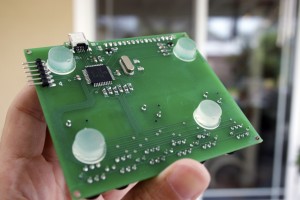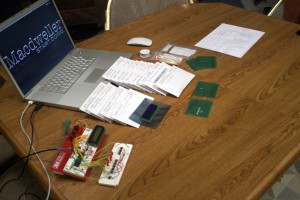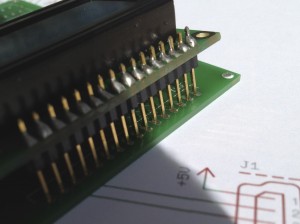My boards arrived on Friday, and I was excited. I’ve had the TuneConsole prototype kicking around on my desk, and it really is useful. My number one complaint with it is that I keep knocking the pushbuttons off the breadboard; they just don’t stay down.
But like I said, my boards are here.
It’s time to build the real thing!
Step 1: Getting Ready
The first step in the process is, put simply, organization. A toy like TuneConsole doesn’t have many parts, but the ones it does have are absolutely tiny. If you have problems identifying through-hole resistors from their color codes, just wait ’til you see the markings on microscopic surface mount stuff. If you get them mixed up, you’ll have a heck of a time telling them apart.
They’re also terrifically easy to lose.
Fortunately, my method of storing parts eliminates most of this concern. I keep everything in #6 3/4 envelopes, all of which are printed with the part number, value, and various other bits of information. I started doing this a couple of months ago, and it’s proven its value: finding things is much easier, which makes everything from prototyping to final assembly much more enjoyable.
So I gather up all the parts for the build, and add in a few tools. My Xytronic soldering station to do the work, complete with new Plato hoof tip; a pair of angled tweezers for holding parts in place; magnifying implements so I can see what I’m doing; and, of course, my new stock of ChipQuik solder and flux. Oh, and some solder wick; that stuff is useful.
With all that gathered, I wrap a large piece of cardboard in tin foil (molten solder doesn’t like to stick to it) and put it down on the table so I don’t accidentally burn something. Not exactly the ideal work surface, but it suffices. Crank up some tunes, and I’m ready to go.
I eye the prototype sitting next to my laptop, and wonder if the “production” version is going to work as well…
Interlude: Stupid Designer Trick
I have a habit of checking the fit of various components when I get a set of boards in. Until now, it was just paranoia: if I screwed up somewhere, I didn’t want to find out halfway through the build that a part didn’t fit. It would be a waste of whatever components I’d already put down.
And on this occasion, there was a problem.
Turns out, I used someone else’s PCB footprint for the display (Adafruit’s I think), and I completely forgot to check the dimensions on the drill holes. I even remember making a mental note to do that, but I was so impatient that I just forgot. And now, it was coming back to bite me.
The drill holes in the LCD footprint were too small to fit a standard header.
Cue swearing.
I could have the boards redone, of course, but that’s an expensive option. I’ve already spent more than I wanted to on this project, so that’s out. But what to do? It’s gotta have the display, and the display won’t fit, at least as designed.
After chewing on this for a while and coming up with various random ideas (ribbon cable? that could work!), I finally give up. Where normally I’d probably let it sit for a few days out of sheer frustration, I really wanted to play with surface mount, so I decided to build the rest of it. It’ll work without the display, and at least I’ll know if the rest of the board is good.
Besides, I’ll figure something out, right?




Oh wow that hurts, the iTunes playlist. Oh thats painful. I feel for you. That hurts. I’ve had my fair share of that kind of stuff. No worries. You are in great company.
Here’s another good way to keep your SMD parts sorted, while supplies last:
http://www.sparkfun.com/products/11213
Nice write-up! I noted your frustration at soldering the micro-controller, I work soldering these things manually on an almost day-to-day basis. I have found that the quickest way to solder these parts (without expensive re-flow equipment) is to accept that there will be solder bridges and be quite liberal in spreading solder across the pins, mopping up the excess (as you did) with solder braid. A solder pump could be a useful investment if you plan on doing more with SMD components as it can save considerably on using braid. Also a magnifying lens of some kind is a must (A 10x jewellers lens is a good option) Keep up the good work.
Thanks for the tips Steve! whenever I’m working on a project like that I typically have parts all over the place and almost always leave a burn mark or two when soldering. The cardboard and foil trick worked great, my wife always has a fit because for fine work I usually set eveything up on the kitchen table.